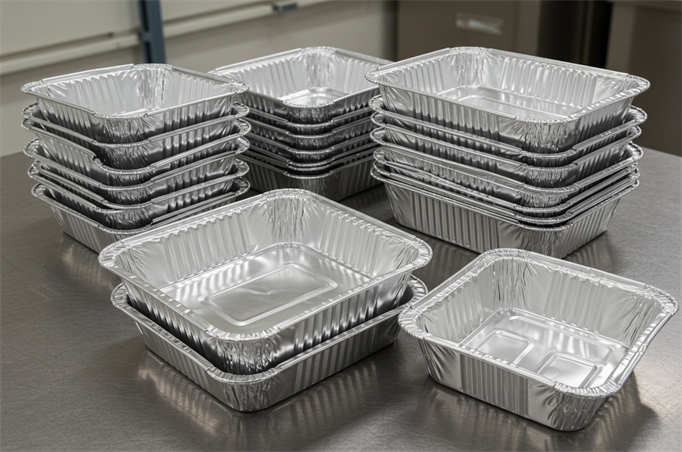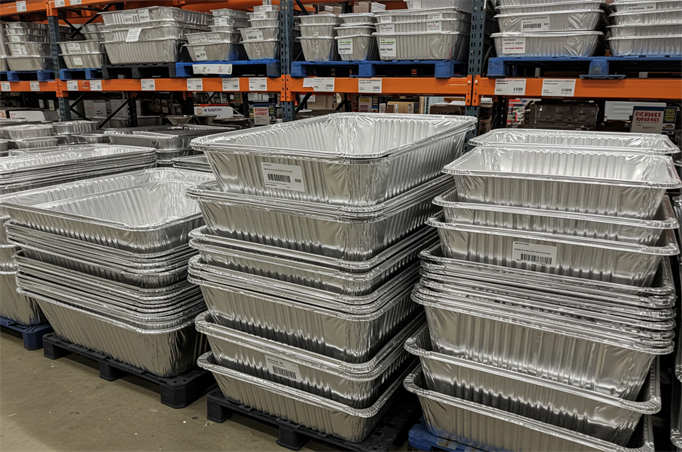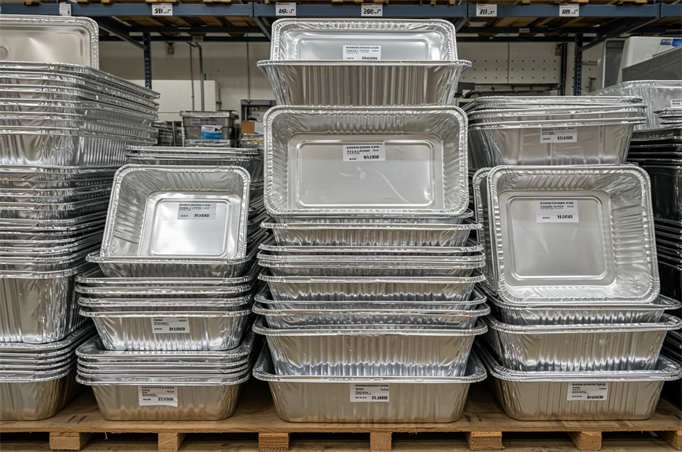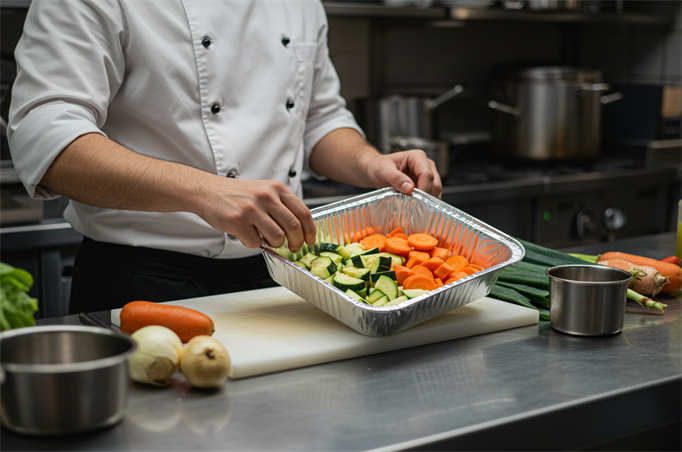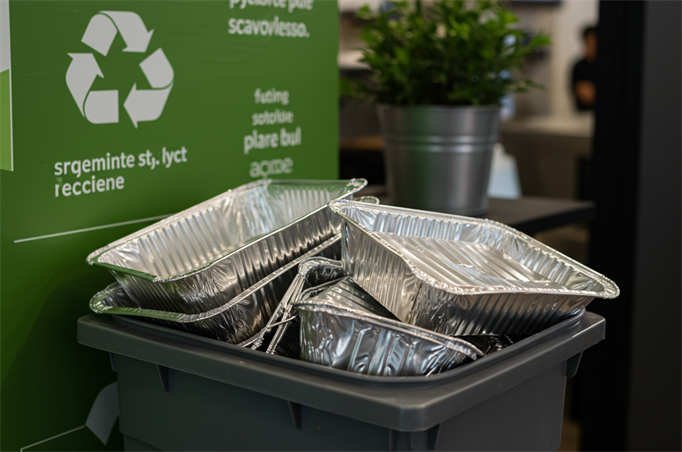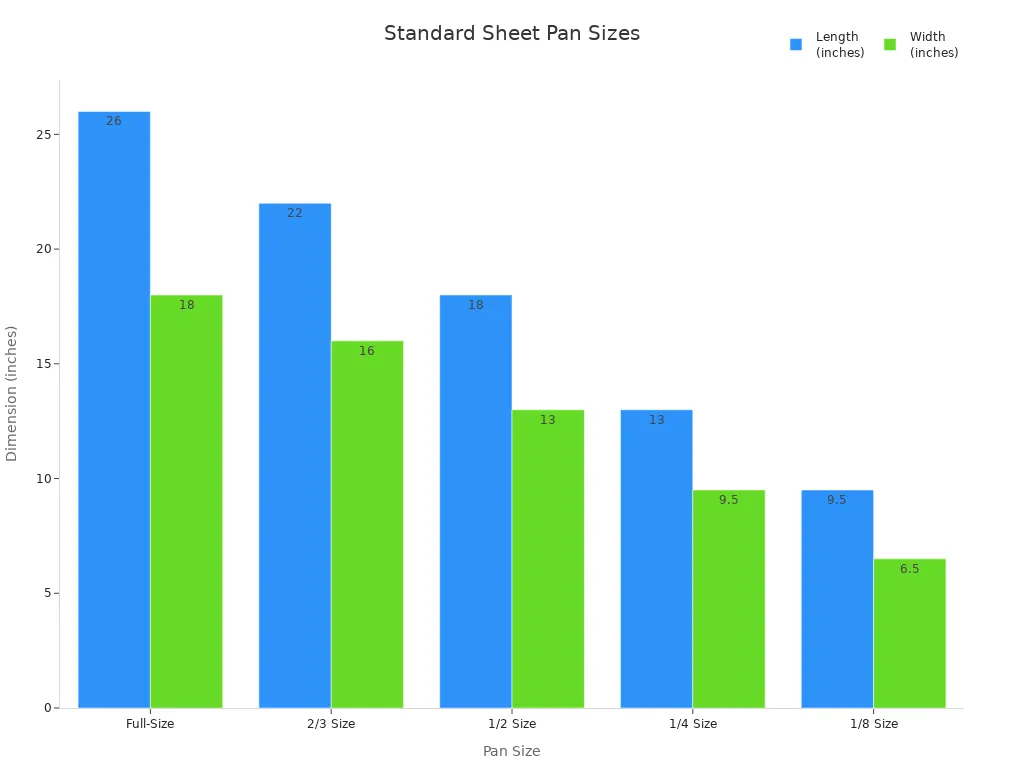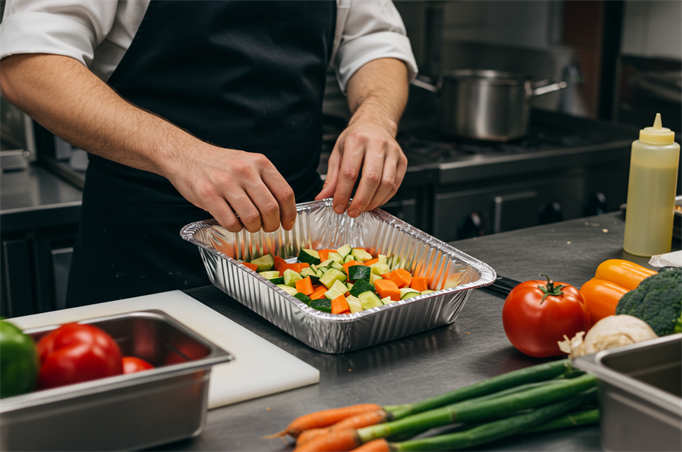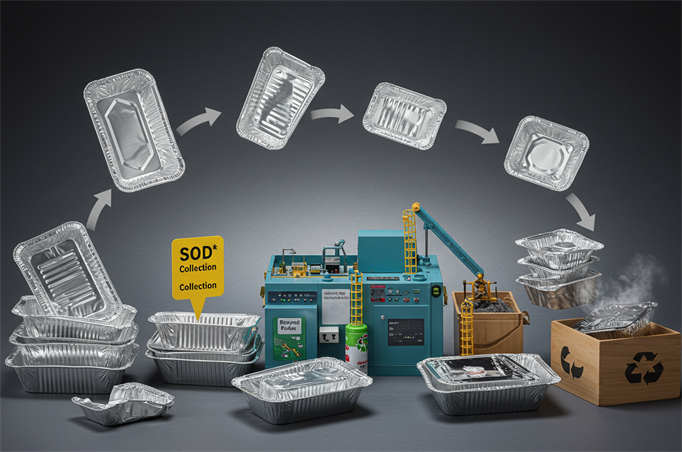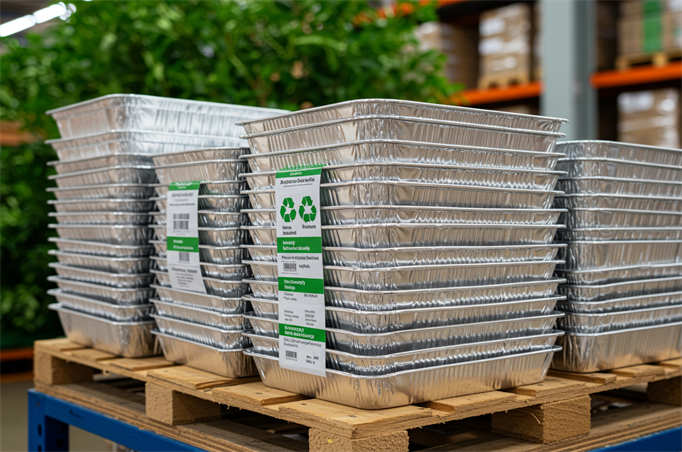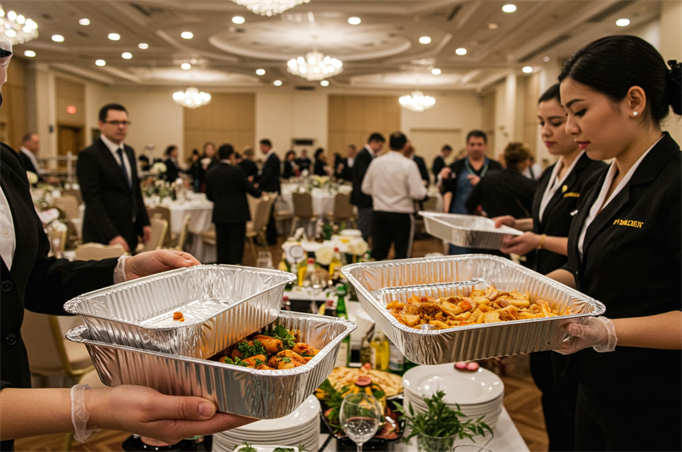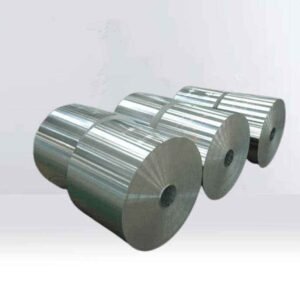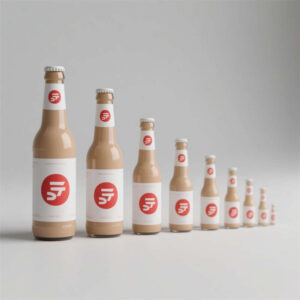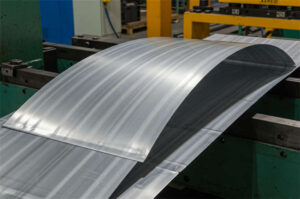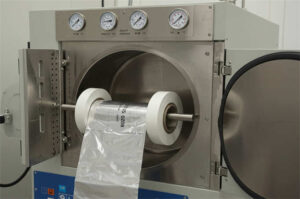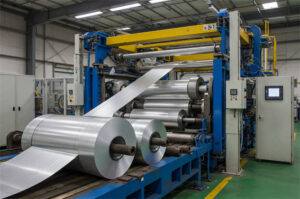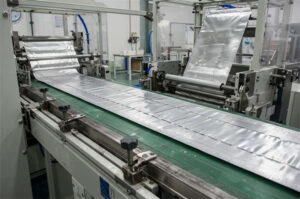Have you ever taken out brownies that cooked unevenly or seen cake batter overflow from your pan? The size of the aluminum pan you pick can change how your baked treats turn out. Aluminum pan sizes change baking time, texture, and even how easy it is to clean up. Picking the right pan helps you bake with confidence and avoid common kitchen mistakes.
Основные выводы
- Choosing the right aluminum pan size helps your baked goods cook evenly and look great.
- Small pans work best for single servings and quick meals, while large pans suit big batches and parties.
- Medium pans fit most home baking needs and offer good heat distribution and easy cleanup.
- Thicker aluminum pans resist warping and last longer, giving better baking results.
- Always check your recipe for the recommended pan size and adjust baking time if you change pans.
Why Pan Size Matters
Baking Time and Texture
When you choose a pan, you control how your baked goods cook. The size of your pan affects how heat moves through the batter or dough. A smaller pan holds batter deeper, so the center takes longer to bake. You might see the edges cook faster than the middle. A larger pan spreads the batter thinner, so everything bakes more quickly and evenly.
Tip: If you use a pan that is too small, your cake or bread may rise too high and crack on top. If you use a pan that is too large, your treat may turn out flat and dry.
You can use this knowledge to get the texture you want. For chewy brownies, use a smaller pan. For thin, crisp bars, use a larger one. Always check your recipe for the recommended pan size. If you change the pan, you may need to adjust the baking time.
Recipe Results
Aluminum pan sizes can change how your recipe turns out. If you use the wrong size, you may not get the results you expect. For example, a loaf of bread in a large pan may spread out and not rise well. A cake in a small pan may overflow and make a mess in your oven.
- Use the correct pan size to:
- Get the right shape and height
- Avoid undercooked centers or burnt edges
- Make sure your dessert looks and tastes as it should
If you want to double a recipe, you need to pick a bigger pan or use two pans. Always remember that pan size is just as important as the ingredients you use.
Common Aluminum Pan Sizes
Loaf Pans
You often use loaf pans for baking bread and pound cakes. Most loaf pans measure about 9 x 5 inches, but you may also see 8 x 4 or 10 x 5 inches. Some bakers prefer an 8.5 x 4.5-inch pan with straight edges for a more refined look. Aluminum loaf pans heat up quickly and bake bread evenly. The straight sides help your bread keep its shape and rise well. You can also use these pans for meatloaf or quick breads.
Tip: Aluminum loaf pans with reinforced rims resist warping and last longer.
Sheet Pans
Sheet pans come in many sizes. The most common for home baking is the half sheet pan, which measures 13 x 18 inches. You can also find full-size (18 x 26 inches), two-thirds (16 x 22 inches), quarter (9.5 x 13 inches), and eighth (6.5 x 9.5 inches) sheet pans. These pans work well for cookies, roasting vegetables, and baking sheet cakes. The size you choose affects how much food you can bake at once and how evenly it cooks.
| Sheet Pan Size | Dimensions (inches) |
|---|---|
| Full-Size | 18 x 26 |
| 2/3 Size | 16 x 22 |
| 1/2 Size | 13 x 18 |
| 1/4 Size | 9.5 x 13 |
| 1/8 Size | 6.5 x 9.5 |
Square and Rectangular Pans
Square pans, like the 8 x 8-inch size, are great for brownies and small cakes. Rectangular pans, such as the 9 x 13-inch, are perfect for casseroles and sheet cakes. The straight edges of these pans give you more surface area, which helps with browning and crisping. You get even cooking and a modern look for your baked goods. However, you may need to pay extra attention to the corners, as they can cook faster than the center.
- Square pans: 8 x 8 inches
- Rectangular pans: 9 x 13 inches
Round Cake Pans
Round cake pans usually come in 6, 8, or 9-inch diameters. Depths range from 2 to 4 inches. Deeper pans make taller cakes, while shallower pans give you thinner layers. If you want even layers for a layer cake, choose straight-sided pans—aluminum round pans heat evenly, which helps your cake bake with a good texture and color.
Muffin and Cupcake Pans
Muffin and cupcake pans come in mini, standard, and jumbo sizes. Standard pans have cups about 2 inches wide at the bottom and 2.5 inches at the top. Mini pans bake faster, while jumbo pans need more time. Using the right size helps you control portions and get even results. Fill each cup about two-thirds full to avoid overflow.
Pie and Tart Pans
Pie and tart pans usually measure 9 inches across, but you can find smaller or larger ones. Aluminum pans conduct heat well, so your crust browns nicely and stays crisp. Smaller pans bake faster, while larger or deep-dish pans need more time for the filling to cook through.
Casserole and Specialty Pans
Casserole pans often come in rectangular shapes, like 9 x 13 inches. Specialty pans include jelly roll pans, angel food cake pans, and bundt pans. Aluminum pans in these shapes heat evenly and are easy to handle. Some have lids to keep moisture in, which is helpful for dishes that need to stay juicy.
You have many aluminum pan sizes to choose from. Picking the right one helps you get the best results for every recipe.
Pros and Cons of Aluminum Pan Sizes
Small Aluminum Pan Sizes
Small aluminum pans are suitable for one person or small meals. You can use them for mini casseroles or to reheat food. Many restaurants use these pans for meal kits or single dishes.
Преимущества:
- You can bake or roast small amounts and not waste food.
- These pans are light so that you can carry them easily.
- Disposable pans mean you do not have to wash them.
- They keep food warm longer, which helps keep it tasty.
- You can freeze meals in them and eat them later.
- They fit in air fryers and microwaves if they are safe.
- Aluminum heats up fast, so your food cooks evenly.
- Some small pans come in colors to make food look nice.
- They cost less and help you save money if you bake a lot.
Disadvantages:
- Small pans are not suitable for big meals or recipes.
- Thin pans can bend if you use high heat.
- Some foods, like tomato sauce, can react with aluminum if not coated.
- You may need to change baking times for tiny pans.
Tip: Use small aluminum pans to control portions and make meal prep easy. They help you waste less food and make cleanup fast.
Medium Aluminum Pan Sizes
Medium aluminum pans, like pie or cake pans, work well for most baking at home. You can use them for pies, cakes, brownies, and casseroles.
| Характеристика | Описание |
|---|---|
| Диаметр | 9″ top outside rim, 8⅛” inside diameter |
| Depth | ⅞” medium depth |
| Материал | 40-gauge aluminum foil |
| Capacity | 24 fluid oz. |
| Heat Distribution | Even heat conduction due to thin aluminum foil |
| Использование | Designed for typical home baking, suitable for standard pie recipes |
| Удобство | Disposable, recyclable, no cleanup needed |
Преимущества:
- Medium pans fit in most ovens and work for many recipes.
- You get even heat, so your baked goods cook well.
- These pans are easy to hold and store.
- Disposable pans make cleaning up fast.
- You can recycle many of these pans, which is good for the earth.
Disadvantages:
- Some medium pans can bend if you put heavy food in them.
- Thin pans can warp if you use very high heat.
- Aluminum can react with sour foods if the pan is not coated.
- You might need more than one pan for big parties.
Примечание: Medium aluminum pan sizes are best for most baking. They give you good results and are simple to use for many recipes.
Large Aluminum Pan Sizes
Large aluminum pans are used in restaurants and for baking big batches. You might use them for big cakes, roasting lots of veggies, or making food for parties.
| Benefit Category | Подробности |
|---|---|
| Heat Conductivity | Aluminum pans conduct heat 15x faster than stainless steel, reducing batch baking times by 25%. |
| Целостность конструкции | 16-gauge pans support heavy loads (up to 15 lbs) without buckling. |
| Долговечность | Thicker pans resist warping at high temperatures and last longer. |
| Weight | Full-size pans weigh about 1.2 lbs, lighter than steel alternatives. |
| Универсальность | Suitable for oven, freezer, and sous-vide; non-reactive surface prevents flavor leaching. |
| Portion Control | Standard sizes and compartments help with portioning and meal assembly. |
| Storage Efficiency | Stackable design saves up to 40% storage space. |
| Эффективность затрат | Heavier gauge pans lower replacement costs over time. |
| Устойчивое развитие | Aluminum pans are recyclable and support sustainable practices. |
Additional Pros:
- You can move lots of food easily because the pans are light.
- These pans keep food warm longer, which is suitable for catering.
- Disposable pans save you time on cleaning up.
- They work in freezers and ovens, even at very hot or cold temperatures.
Cons:
- Large aluminum pans can bend, especially if they are thin or food is not spread out. Warping happens when the bottom gets hot faster than the sides, so the pan bends. Этот can make the pan sit unevenly in the oven and bake unevenly.
- Handling big pans can be hard. They may not fit in home ovens, and carrying them when full is tough.
- Thin pans can bend for good after many uses or quick temperature changes.
- Large pans can be hard to store if your kitchen is small.
Примечание: Pick thicker, stronger pans to stop warping. Always spread food out and avoid quick temperature changes to keep your pans nice.
You can find aluminum pan sizes for any need, from one meal to big parties. Each size has its advantages and disadvantages. Knowing these helps you pick the best pan for your baking.
Choosing the Right Aluminum Pan Size
Recipe and Batch Size
When you pick a pan, start by thinking about your recipe and how much food you want to make. The right pan size helps your dish bake evenly and look great. If you bake for one or two people, small pans work best. For family meals, medium pans hold enough food without wasting space. Large pans help when you cook for a crowd or want to make big batches.
- Small pans are perfect for single servings or desserts.
- Medium pans fit casseroles, brownies, and main dishes.
- Large pans suit big roasts or party-sized meals.
Batch size matters, too. If you use a pan that is too small, the batter can overflow. If the pan is too big, your food may dry out. Always match your pan to the amount of food you plan to bake. Этот keeps your baking even and helps with portion control.
Tip: Check your recipe for the recommended pan size. Adjust if you change the batch size.
Oven and Storage Space
Your oven and kitchen space also affect your choice. Before you start baking, make sure the pan fits in your oven. Some pans are too large for home ovens, so measure first. Shallow pans work well for roasting and browning. Deep pans are better for layered dishes or foods with lots of liquid.
- Choose pans that nest or stack to save storage space.
- Straight-sided pans are easier to store and stack.
- Look for pans with lids if you need to cover or transport food.
A good fit in your oven helps heat move evenly. Этот gives you better results and saves time.
Handling and Durability
You want pans that last and are easy to use. Heavy-gauge aluminum pans resist warping and last longer. Thicker pans also spread heat better, so your food cooks evenly. Anodized aluminum pans give you a non-reactive surface and extra strength.
- Thicker pans hold their shape and work well for big batches.
- Lightweight pans are easy to lift, even when full.
- Avoid using abrasive cleaners to keep your pans in good shape.
- Check your pans for dents or damage before each use.
If you bake often, invest in sturdy pans. They make baking safer and more enjoyable. Aluminum pan sizes offer many options so that you can find the right fit for your needs.
Choosing the right pan size helps you bake with better results and less stress. You get even cooking, easier cleanup, and less waste when you match your pan to your recipe and oven. Many people find small pans convenient for single meals and quick cleanup. You can stack, store, and transport them with ease. Try different sizes to see what works best for your baking style. 🍰
Часто задаваемые вопросы
What happens if you use the wrong size aluminum pan?
If you use the wrong pan, baking can be uneven. Batter might spill over, or desserts may look flat. Always read your recipe to find the right pan size. If you use a different pan, change the baking time. Watch your food so it does not burn or stay raw.
Can you use aluminum pans for acidic foods?
Foods like tomatoes and citrus are acidic and can react with plain aluminum. Этот can make your food taste or look different. Use anodized or coated aluminum pans for these foods. That way, you avoid problems with taste or color.
How do you prevent aluminum pans from warping?
Pick pans that are thick and heavy. Let pans cool before you wash them. Do not change the temperature too fast. These tips help your pans last longer and keep their shape.
Are disposable aluminum pans safe for baking?
Yes, you can bake safely in disposable aluminum pans. They work for most recipes. Put them on a strong baking sheet for support. Этот helps when your dish is heavy or has lots of liquid.

